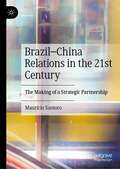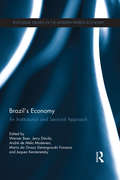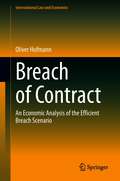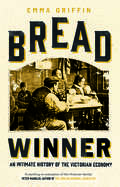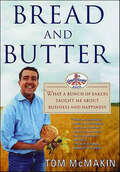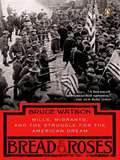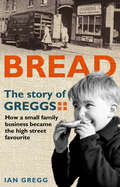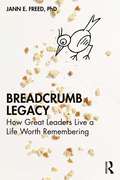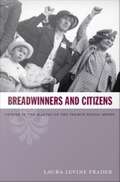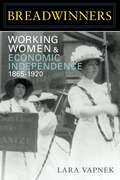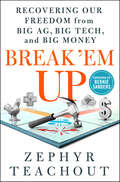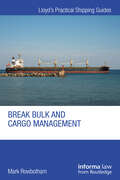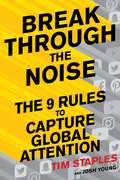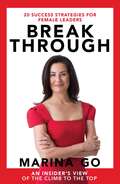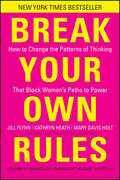- Table View
- List View
Brazillionaires: Wealth, Power, Decadence, and Hope in an American Country
by Alex CuadrosFor readers of Michael Lewis comes an engrossing tale of a country's spectacular rise and fall, intertwined with the story of Brazil's wealthiest citizen, Eike Batista--a universal story of hubris and tragedy that uncovers the deeper meaning of this era of billionaires. When Bloomberg News invited the young American journalist Alex Cuadros to report on Brazil's emerging class of billionaires at the height of the historic Brazilian boom, he was poised to cover two of the biggest business stories of our time: how the giants of the developing world were triumphantly taking their place at the center of global capitalism, and how wealth inequality was changing societies everywhere. The billionaires of Brazil and their massive fortunes resided at the very top of their country's economic pyramid, and whether they quietly accumulated exceptional power or extravagantly displayed their decadence, they formed a potent microcosm of the world's richest .001 percent. Eike Batista, a flamboyant and charismatic evangelist for the country's new gospel of wealth, epitomized much of this rarefied sphere: In 2012, Batista ranked as the eighth-richest person in the world, was famous for his marriage to a beauty queen, and was a fixture in the Brazilian press. His constantly repeated ambition was to become the world's richest man and to bring Brazil along with him to the top. But by 2015, Batista was bankrupt, his son Thor had been indicted for manslaughter, and Brazil--its president facing impeachment, its provinces combating an epidemic, and its business and political class torn apart by scandal--had become a cautionary tale of a country run aground by its elites. Over the four years Cuadros was on the billionaire beat, he reported on media moguls and televangelists, energy barons and shadowy figures from the years of military dictatorship, soy barons who lived on the outskirts of the Amazon, and new-economy billionaires spinning money from speculation. He learned just how deeply they all reached into Brazilian life. They held sway over the economy, government, media, and stewardship of the environment; they determined the spiritual fates and populated the imaginations of their countrymen. Cuadros's zealous reporting takes us from penthouses to courtrooms, from favelas to extravagant art fairs, from scenes of unimaginable wealth to desperate, massive street protests. Within a business narrative that deftly explains and dramatizes the volatility of the global economy, Cuadros offers us literary journalism with a grand sweep. Praise for Brazillionaires"A wild, richly reported tale about Brazil's recent economic rise and fall, and some of the biggest, most colorful characters in business in Brazil who now have a global reach. . . . Cuadros's story really takes off when he focuses on Eike Batista, an over-the-top one-time billionaire who became the country's corporate mascot, only to go bankrupt in a dramatic unraveling."--Andrew Ross Sorkin, the New York Times "In this excellent book [Cuadros] has managed to use billionaires to illuminate the lives of both rich and poor Brazilians, and all those in between."--The Economist "Brazil's shocking rise and even more shocking fall is one of the biggest stories of our young century. Alex Cuadros tells it through the stories of its billionaires--whose genius, hubris, and (in some cases) utter folly come through in vivid, human detail throughout this book."--Brian Winter, co-author of The Accidental President of BrazilFrom the Hardcover edition.
Brazil–China Relations in the 21st Century: The Making of a Strategic Partnership
by Maurício SantoroThis book explores the bilateral relationship between Brazil and China in modern history, environment, economics, and contemporary Brazilian politics. As China has become Brazil's largest trading partner, importing commodities and exporting manufactures, and a major investor in the country, Brazil's social structure has been upended, with traditional hierarchies jolted and new ones created- in the agribusiness, industry, in the diplomacy of climate change in the Amazon and not least, Brazil's traditional relationship with the United States. In this incisive text, one of Brazil's leading political scientists explores how China, the X factor of international relations, can transform a nation's politics; it will be of interest to economists, scholars of geopolitics, of China's Belt and Road Initiative and of Latin America politics.
Brazil—Japan Cooperation: From Complementarity to Shared Value
by Nobuaki Hamaguchi Danielly RamosThis is an open access book. Relations between Brazil and Japan progressed dynamically in the 1960s and 1970s, centering on the substantial complementarity between Japan’s needing primary goods to sustain high economic growth and Brazil’s seeking non-hegemonic investment to invigorate its resource potential. Now that this complementarity has lost significance, the two countries are restructuring their relations to protect shared values of democracy, freedom, the rule of law, and the need for maintaining good relations with both China and the United States. Analyzed here is the development of this renewed bilateral relationship in multiple directions: productivity, global environment and health, migration, and triangular cooperation in third countries’ development. Facing the prospect of a declining population, Japan may become more open to international migration, but the experience with Japanese-descent Brazilian workers since the amendment of the migration control law in 1990 presents many lessons and challenges for the symbiosis of multicultural groups. Brazil, for its part, needs to address social inequality. To this end, it is fundamental to improve the quality of work.This book argues that Brazil and Japan can benefit from cooperation in managing those country-specific issues. It also discusses ways that Brazil and Japan can profit from coordinating action on global problems such as greenhouse gas reduction, mitigation of tropical diseases, healthy community building, and high-quality infrastructure for poverty reduction.
Brazil’s Economy: An Institutional and Sectoral Approach (Routledge Studies in the Modern World Economy)
by Werner Baer, Jerry Dávila, André de Melo Modenesi, Maria da Graça Derengowski Fonseca and Jaques KerstenetzkyThe past century has witnessed profound transitions in Brazil’s economy: from a surge of industrialization connected to export economy, to state projects of importsubstitution industrialization, followed by a process of neoliberal global market integration. How have Brazilian entrepreneurs and businesses navigated these contexts? This comprehensive text explores the institutional and sectoral structure of the Brazilian economy through a collection of new case studies, examining how key institutions work within Brazil’s specific economic, political and cultural context. Offering a long-term evolutionary perspective, the book explores Brazil’s economic past in order to offer insights on its present and future trajectory. The contributions gathered here offer fresh insights into representative sectors of Brazil’s economy, from aerospace to software, television, music and banking, paying particular attention to sectors that are likely to drive future growth. Chapters include questions about the roles of foreign and state capital, changes in market regulation, the emergence of new technologies, the opening of markets, institutional and organizational frameworks, and changing management paradigms. When examined together, the contributions shed light not only on Brazilian business history, but also on the country as a whole. Brazil’s Economy: An Institutional and Sectoral Approach offers fascinating reading for anyone with an interest in: Latin American Economics; the business history of the region; and in doing business in present-day Latin America.
Brazos Partners and Cheddar's Inc.
by Josh Lerner G. Felda Hardymon Ann LeamonRandall Fojtasek, a partner at Brazos Private Equity Partners, must decide whether to invest more money in Cheddar's restaurant chain, which the firm invested in 10 months earlier. The incremental investment would fund a real estate subsidiary that would own the property on which Cheddar's built its stores, rather than its traditional approach of sale and leaseback. As he considers the issue, Fojtasek must decide how to price the new stock, how to structure the deal to limit his firm's dilution, and how to manage the personality issues involved.
Brazos Partners and the Tri-Northern Exit
by Matthew Rhodes-Kropf Nathaniel BurbankRandall Fojtasek, a partner at Dallas-based Brazos Private Equity Partners, must decide whether now is the time to sell his firm's investment in Tri-Northern Distribution. Brazos, a middle-market leveraged buyout group, created the company two years earlier through the acquisition of two electronic security distribution companies: Tri-Ed Distribution and Northern Video Systems. Twenty-four months after successfully integrating the two companies, Brazos has received two attractive offers for the combined distributor. With the company's management projecting double-digit growth for 2012, however, it is far from clear that now is the optimal time to exit from the firm's third fund.
Brazos Partners: The CoMark LBO
by Josh Lerner G. Felda Hardymon Ann LeamonThe partners of a new midmarket buyout fund are working on a buyout of a closely held modular building company. Although originally structured as a stock deal, they have realized that an asset deal would be preferable from their point of view and are trying to determine what benefits it might hold for the sellers, whose continuing involvement in the company is essential for success. This case describes the process of the deal's due diligence and the state of the LBO industry in the early 21st century.
Breach of Contract: An Economic Analysis of the Efficient Breach Scenario (International Law and Economics)
by Oliver Hofmann“Efficient breach” is one of the most discussed topics in the literature of law and economics. What remedy incentivizes the parties of a contract to perform contracts if and only if it is efficient? This book provides a new perception based on an in-depth analysis of the impact the market structure, asymmetry of information, and deviations from the rational choice model have, comprehensively. The author compares the two predominant remedies for breach of contract which have been adopted by most jurisdictions and also found access to international conventions like the Convention on Contracts for the International Sale of Goods (CiSG): Specific performance and expectation damages. The book illustrates the complexity such a comparison has under more realistic assumptions. The author shows that no simple answer is possible, but one needs to account for the circumstances. The comparison takes an economic approach to law applying game theory. The game-theoretic models are consistent throughout the entire book which makes it easy for the reader to understand what effects different assumptions about the market structure, the distribution of information, and deviations from the rational choice model have, and how they are intertwined.
Bread Winner: An Intimate History of the Victorian Economy
by Emma Griffin&“A powerful story of social realities, pressures, and the fracturing of traditional structures.&”—Ruth Goodman, Wall Street Journal Nineteenth century Britain saw remarkable economic growth and a rise in real wages. But not everyone shared in the nation&’s wealth. Unable to earn a sufficient income themselves, working-class women were reliant on the &‘breadwinner wage&’ of their husbands. When income failed, or was denied or squandered by errant men, families could be plunged into desperate poverty from which there was no escape. Emma Griffin unlocks the homes of Victorian England to examine the lives – and finances – of the people who lived there. Drawing on over 600 working-class autobiographies, including more than 200 written by women, Bread Winner changes our understanding of daily life in Victorian Britain.
Bread and Butter: What a Bunch of Bakers Taught Me About Business and Happiness
by Tom McMakinBread and Butter is a book with three parts: First, it's the story of the birth of an extraordinarily successful kind of business called a "freedom franchise": Great Harvest Bread Co., which began as one bakery 25 years ago, is now a $60-million-a-year company with 140 stores in 40 states.Second, it's the story of one employee's success--the author, Tom McMakin, who was looking for a job and found a lifestyle. McMakin's immersion into Great Harvest is a model for modern entrepreneurship and an inspiration in this age of failed dot-coms and dissatisfied young employees.Third, McMakin uses GH's experience to provide advice for everyone from dreamers starting their own multi-million-dollar companies to small-business owners to someone who doesn't know what she wants to do. Things like: creating a "learning community" using email and an extranet; operating without loans, relying instead on profits for reinvesting in the company; GH's "40-hour" rule so no one works more than 40 hours a week; and more. Bread and Butter can help you discover how, instead of living your life in service to the business, you can create a business in service of your life.
Bread and Roses: Mills, Migrants, and the Struggle for the American Dream
by Bruce WatsonThe 1912 textile strike in Lawrence, Massachusetts was a watershed moment in labor history as significant as the Haymarket bombing in Chicago and the Triangle fire in New York. In Bread and Roses, veteran journalist Bruce Watson provides a long-overdue account of the strike that began when textile workers stormed out of the mills in Lawrence on a frigid January day. Despite owners' predictions to the contrary, the walkout soon became a protracted Dickensian drama that included twenty-three thousand strikers from fifty-one nations singing as they paraded through Lawrence, bayonet-toting militiamen patrolling the streets, and the daring evacuation of the strikers' tattered and hungry children to Manhattan, where they lived with strangers and wrote loving letters to their parents on the picket line. Based on newspaper accounts, magazine reportage, and oral histories, Bread and Rosesis vividly narrated and teeming with colorful characters-including rags-to-riches mill owner William Wood and radical labor leader "Big Bill" Haywood. A rousing history with the narrative drive of a novel, Bread and Rosesis the true-to-life tale of a strike that became the fabric of a community and an inspiration to workers around the world.
Bread-and-Butter Deals: Customers and Suppliers
by Danny Ertel Mark GordonIt's the small "n" negotiations where value can be captured or squandered that can make the difference between success and failure in the business world. This chapter shows you why.
Bread: The Story of Greggs
by Ian GreggWhen Ian Gregg was just a boy he joined his father at work selling pies from his van to miners’ wives around Newcastle. Now retired, he can look back on a business that began as a husband-and-wife team in the 1930s, and survived a world war and two major recessions to become our favourite bakery, beloved by everyone from children to office workers to soldiers overseas.Ian Gregg led the family firm as it grew, employing generations of families from around Newcastle and then becoming a public company with bakeries in Scotland and across the North, and now with shops on every high street. This is a story of extraordinary success, but it is also a triumphant tale of how doing right by your people makes for great business. Bucking every trend, Greggs have always put their customers, employees and local communities before quick profits for directors and shareholders. Their astounding record of charitable works includes hardship grants, an environment fund, sponsorship of the North East Children’s Cancer run and over £1 million raised annually for Children in Need.Ian Gregg will donate all of his royalties and Greggs plc will donate all its profits from the sale of this book to the Greggs Foundation to help fund more Breakfast Clubs for children.
Breadcrumb Legacy: How Great Leaders Live a Life Worth Remembering
by Jann E. FreedLegacy can seem far off and out of reach, but it doesn’t happen at journey’s end and it’s not only for the rich and famous. Legacy is now, and this book shows leaders how you can find and leave meaning on a daily basis. Jann E. Freed, PhD, introduces her Breadcrumb Legacy™ framework, a radical but pragmatic approach, made up of small actions you consciously take over time that accumulate into the trail, or legacy, you’ll leave behind. Breadcrumb Legacy is also a mindset, an awareness of the impact you’re having on your relationships, your organization, and your family, in every communication and interaction. This book is the guide to leaving a trail of meaning throughout your life and career. Based on in-depth interviews, Breadcrumb Legacy provides inspiration and practical stories for living a life worth remembering.
Breadwinners and Citizens: Gender in the Making of the French Social Model
by Laura Levine FraderLaura Levine Frader's synthesis of labor history and gender history brings to the fore failures in realizing the French social model of equality for all citizens. Challenging previous scholarship, she argues that the male breadwinner ideal was stronger in France in the interwar years than scholars have typically recognized, and that it had negative consequences for women's claims to the full benefits of citizenship. She describes how ideas about masculinity, femininity, family, and work affected post-World War I reconstruction, policies designed to address France's postwar population deficit, and efforts to redefine citizenship in the 1920s and 1930s. She demonstrates that gender divisions and the male breadwinner ideal were reaffirmed through the policies and practices of labor, management, and government. The social model that France implemented in the 1920s and 1930s incorporated fundamental social inequalities. Frader's analysis moves between the everyday lives of ordinary working women and men and the actions of national policymakers, political parties, and political movements, including feminists, pro-natalists, and trade unionists. In the years following World War I, the many women and an increasing number of immigrant men in the labor force competed for employment and pay. Family policy was used not only to encourage reproduction but also to regulate wages and the size of the workforce. Policies to promote married women's and immigrants' departure from the labor force were more common when jobs were scarce, as they were during the Depression. Frader contends that gender and ethnicity exerted a powerful and unacknowledged influence on French social policy during the Depression era and for decades afterward.
Breadwinners: Working Women and Economic Independence, 1865-1920 (Women, Gender, and Sexuality in American History)
by Lara VapnekLara Vapnek tells the story of American labor feminism from the end of the Civil War through the winning of woman suffrage. During this period, working women in the nation's industrializing cities launched a series of campaigns to gain economic equality and political power. This book shows how working women pursued equality by claiming new identities as citizens and as breadwinners. Analyzing disjunctions between middle-class and working-class women's ideas of independence, Vapnek highlights the agendas for change advanced by leaders such as Jennie Collins, Leonora O'Reilly, and Helen Campbell and organizations such as the National Consumers' League, the Women's Educational and Industrial Union, and the Women's Trade Union League. Locating households as important sites of class conflict, Breadwinners recovers the class and gender politics behind the marginalization of domestic workers from labor reform while documenting the ways in which working-class women raised their voices on their own behalf.
Break 'Em Up: Recovering Our Freedom from Big Ag, Big Tech, and Big Money
by Zephyr Teachout"[We need] a grassroots, bottom-up movement that understands the challenge in front of us, and then organizes against monopoly power in communities across this country. This book is a blueprint for that organizing. In these pages, you will learn how monopolies and oligopolies have taken over almost every aspect of American life, and you will also learn about what can be done to stop that trend before it is too late." —From the foreword by Bernie Sanders.A passionate attack on the monopolies that are throttling American democracy.Every facet of American life is being overtaken by big platform monopolists like Facebook, Google, and Bayer (which has merged with the former agricultural giant Monsanto), resulting in a greater concentration of wealth and power than we've seen since the Gilded Age. They are evolving into political entities that often have more influence than the actual government, bending state and federal legislatures to their will and even creating arbitration courts that circumvent the US justice system. How can we recover our freedom from these giants? Anti-corruption scholar and activist Zephyr Teachout has the answer: Break 'Em Up.This book is a clarion call for liberals and leftists looking to find a common cause. Teachout makes a compelling case that monopolies are the root cause of many of the issues that today's progressives care about; they drive economic inequality, harm the planet, limit the political power of average citizens, and historically-disenfranchised groups bear the brunt of their shameful and irresponsible business practices. In order to build a better future, we must eradicate monopolies from the private sector and create new safeguards that prevent new ones from seizing power.Through her expert analysis of monopolies in several sectors and their impact on courts, journalism, inequality, and politics, Teachout offers a concrete path toward thwarting these enemies of working Americans and reclaiming our democracy before it’s too late.
Break Bulk and Cargo Management (Lloyd's Practical Shipping Guides)
by Mark RowbothamThis book covers the subjects of break bulk cargo, general cargo and project cargo, and how these cargoes are shipped. It deals with the cargoes themselves, the vessels used for their carriage, and how the carriage is managed using the process of vessel chartering. Alongside these, it also covers offshore vessel management and how offshore supply vessels are used to carry cargoes to offshore oil and gas installations. Break bulk cargo covers a wide variety of cargoes, from project cargo to more varied cargoes carried on an ad hoc basis, often between ports that are not equipped for container traffic. It also covers the carriage of specific cargoes that cannot fit inside or are unsuitable for containers. This includes the carriage of cargoes for major projects, and cargoes for the offshore sector, which is an area covered in a specific section in the book concerning the use of offshore supply vessels. To date, only minor elements of shipping books cover this kind of trade, hence the need for a new book that specifically covers this subject. The focus of this book is providing expert insights and detailed explanations of the practical issues related to all aspects of break bulk and general cargo management. The book is written for legal practitioners, shipping managers, managers of project cargo, oil and gas companies, shipping professionals, charterers, shipbrokers, shippers and anybody else involved in ad hoc vessel chartering for the carriage of break bulk, general and project cargoes. It will also serve as a valuable resource for students of shipping.
Break Down the Barriers Between Fields: Sea Urchin Lollipops and Darwin's Finches--Open Your Mind to Intersectional Ideas
by Frans JohanssonIf we wish to find the intersection of fields, disciplines, or cultures where extraordinary new ideas emerge, we must break down the barriers to creativity created by the mind's tendency to understand the world based on chains of association.
Break Down the Hypothesis: The Importance of the Hypothesis of Record in Evaluating the Progress of an Innovation Initiative
by Chris Trimble Vijay GovindarajanSimple innovations-for example, to improve a process-often have just one unknown. Game-changing innovations, however, have several. That makes the learning challenge more complex. It becomes crucial to break down the hypothesis from an aggregate conjecture to the smaller assumptions that the larger goal depends on. In a best-case scenario, each unknown is isolated and separately tested in laboratory-like conditions. More often, though, the unknowns are interrelated and can be resolved only by actually launching the initiative. In this chapter, the authors explain that the problem is often the absence of a crucial foundation for any conversation about the interpretation of results: a clear and shared hypothesis of record. Using examples from Analog Devices, Allstate Insurance, and IBM, they show how a clearly stated hypothesis of record-composed of a set of conjectures about cause-and-effect relationships between actions and outcomes-serves as a shared frame of reference in any discussions of an innovation initiative's progress. This chapter was originally published as Chapter 5 of "The Other Side of Innovation: Solving the Execution Challenge."
Break Out of Your Network: Ants and Truck Drivers--Making Intersectional Ideas Happen
by Frans JohanssonIn order to successfully execute on innovative ideas generated at the intersection of fields, you will have to fight the seductive urge to remain comfortably within your established network. In fact, many of the resources, processes, and people that made you successful in the past may suddenly be holding you back.
Break Through the Noise: The Nine Rules to Capture Global Attention
by Josh Young Tim StaplesThe odds of getting a video onto YouTube’s front page are 1-in-2,000,0000, but Tim Staples, founder and CEO of Shareability, knows how to make the algorithms of Youtube, Google, Facebook and Instagram work for you – and he has the results to prove it, with a thriving business that has gotten their videos onto YouTube’s front page an amazing 25 times. Here he shows savvy marketers, entrepreneurs, and online celebrity wannabes how they, too, can develop clever videos that amass millions of views.Staples outlines a nine-step approach that anyone can use to launch their product or service without having to invest a fortune. Case studies featured in the book include how Shareability launched ROC Headphones, a multi-million dollar global brand, with a viral video of Cristiano Ronaldo in disguise without spending a nickel on traditional advertising; how they used babies to create the most successful social video ever about the Olympic Games; how they propelled a small pet food company from obscurity to an IPO on the power of two viral videos; and how they helped Cricket Wireless become the most shared brand in the wireless space beating telco powerhouses like Verizon, AT&T and Sprint.
Break Through: 20 Success Strategies For Female Leaders
by Marina GoFrom editor of Dolly at the age of 23 to CEO of Australia's leading digital publisher by her forties, Marina Go is here to inspire the next generation of female leaders to take their rightful place at the top. In Break Through, Marina Go, general manager of Harper's Bazaar, ELLE and Cosmopolitan and the first female chair of Wests Tigers NRL Club, shares an in-depth analysis of the 20 leadership traits that make a successful woman - providing the tools to turn your personal vision of success into a reality. Marina defines success as the ability to achieve the goals she sets for herself. In this deeply personal book, she talks candidly about the challenges and triumphs she has faced over her 30-year career as a leader in the media and publishing industry. Venture inside the cutthroat world of Kerry Packer-era women's magazines, the challenges of balancing a career with two sons and the backlash she's received since becoming chair of a major NRL team. Empowering, inspiring and hilariously candid, Break Through equips you with the skills needed to handle those inevitable career curveballs and gives you the confidence to smash stereotypes and barriers that get in the way of your success - all the while helping you discover the secret to a happy, balanced life along the way.
Break Your Own Rules
by Jill Flynn Kathryn Heath Mary Davis HoltNew York Times Bestseller How women can make it to the top by adopting the new rules of leadership Women hold just 11 percent of the most senior-level leadership positions in U. S. Corporations-a number that hasn't changed in over 30 years. How can women break through? Break Your Own Rules distills the six faulty assumptions (or "rules") most women follow that get in the way-then delivers the correlating new rules that promise to clear that path. For example, the old rule of "Focus on Others" must be replaced by "Take Center Stage," "Hard Work Will Get You There" must yield to "Be Politically Savvy. " "Play It Safe" must give way to "Play to Win. " "Ask Permission" must be replaced by "Proceed Until Apprehended. " Features the results of over 1,700 interviews with executives in Fortune 1000 companies, as well as the authors' new research and ongoing work with over 5,000 professional women Showcases previously-untold stories from high profile women including Ann Moore (CEO, Time Inc. ), Susan Ivey (CEO, Reynolds American), Cathy Bessant (Global Executive for Technology and Operations for Bank of America), Lynn Ford (CEO, ING Solutions), and more Reveals what it really takes for any woman to succeed at the highest levels Foreword by Sharon Allen, Chairman of Deloitte This hands-on guide is for women who are ready to transform their assumptions and join the senior ranks of American business.
Break into Modeling for Under $20: How To Launch Your Career As A Fashion Model
by Judy GossThere's a popular misconception that breaking into the modeling business requires expensive head shots and other costly investments. Judy Goss, a former Ford model and professional with twenty years in the business, has set out to dispel that myth once and for all, and tell you how you can actually launch your career for $20 or less. Judy breaks the process down into four simple steps: Preparation, Pictures, Promotion, and Presentation. She gives countless suggestions and tells all sorts of industry secrets, such as how to:* Determine what type of model you are* Take your own pictures at home in the right poses and clothes* Prepare what to say and do at casting calls* Avoid costly scams* And much more.Judy's expert advice will guide aspiring models of any age through the process of finding representation with a reputable agency or manager, and it provides a valuable resource to fall back on even after models start working. This comprehensive, step-by-step guide is the only book you'll need to launch the career of your dreams.

